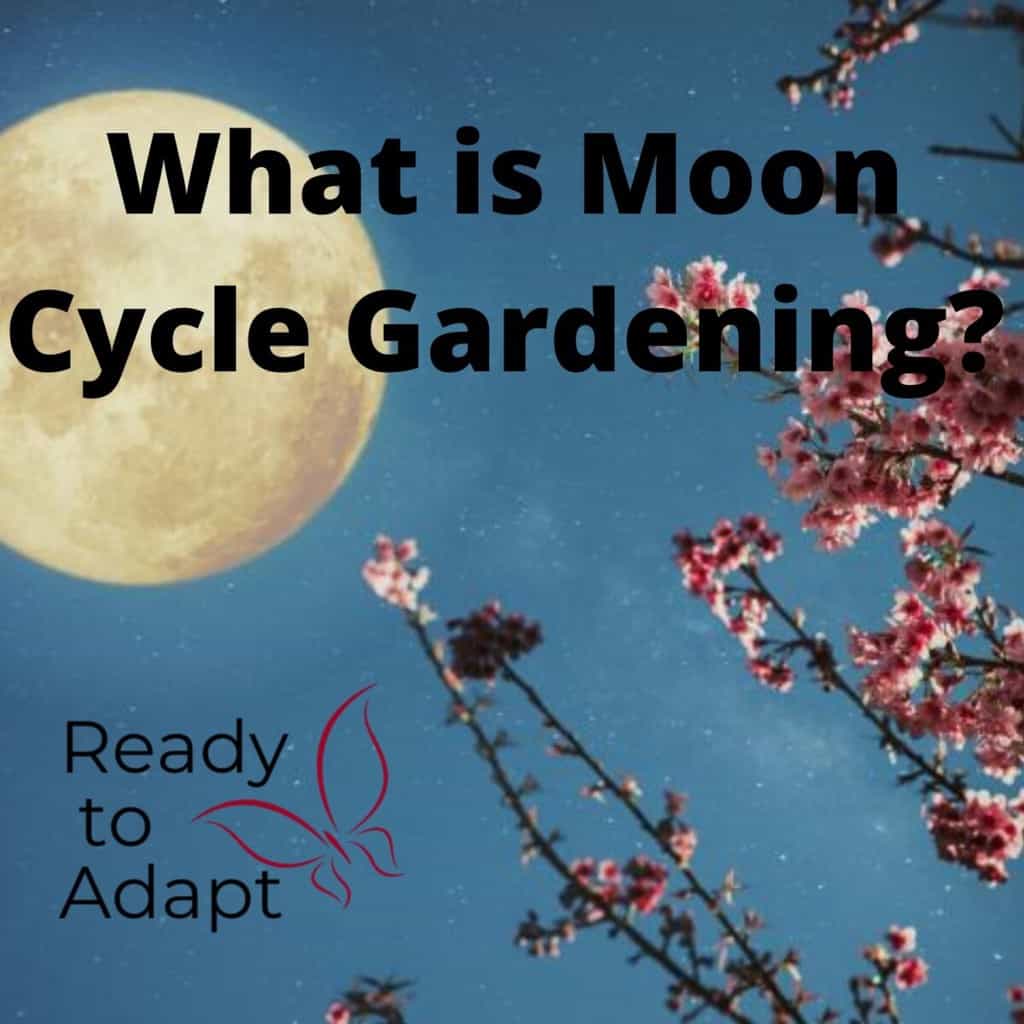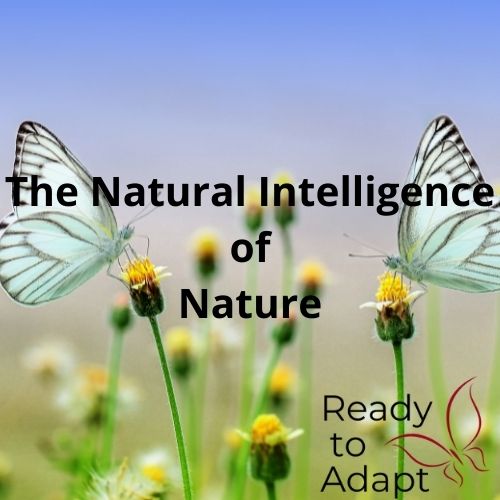This type of gardening conjures up a myriad of images. Everything from druids dancing around stone circles by lantern light to naked moonlit nights in the garden, however you imagine it these images truly have nothing to do with Moon Cycle Gardening. We do know that the moon cycle dictates our high and low tides on the water but does it dictate how we should garden? I set out to find out more.
Gardening by the Moon is a growing trend, but the technique isn’t anything new. Gardeners and farmers have been using moon phase gardening for ages! Best of all, it’s a fairly simple process.
According to the Garden Media Group, Gardening by the Moon is “more than just a phase. Connecting with the phases of the Moon taps into our deep desire to be in tune with nature.” Whatever happens in the world whether trends, or just turning back to a simpler way of life here at Ready to Adapt we are completely in favor of working with nature’s rhythms.
The basic idea behind Gardening by the Moon is that the cycles of the Moon affect plant growth. Just as the Moon’s gravitational pull causes tides to rise and fall, it also affects moisture in the soil.

Proponents say that seeds will absorb more water during the full moon and the new Moon when more moisture is pulled toward the soil surface. This causes seeds to swell, resulting in greater germination and better-established plants. But further research also suggests that there are appropriate times for all gardening activities not just sowing seeds.
“The gravitation of the passing moon pulls the nearest body of water a little away from the solid mass of earth beneath it, and at the same time pulls the earth a little away from the water on the farthest side. In this manner the moon sets up two tidal bulges on opposite sides of the earth.” –Louise Riotte
Gravitational Pull Influences Moisture in the Soil
Moon phase gardening is an idea as old as agriculture, popular in folklore and superstition, but there are scientific ideas to back it up.
The Earth is in a large gravitational field, influenced by both the sun and moon. The tides are highest at the time of the new and the full moon, when sun and moon are lined up with earth. Just as the moon pulls the tides in the oceans, it also pulls upon the subtle bodies of water, causing moisture to rise in the earth, which encourages plant growth.
The highest amount of moisture is in the soil at this time, and tests have proven that seeds will absorb the most water at the time of the full moon. Planting by the phases of the moon will keep in rhythm with the alternating gravitational pull.
The Moon also impacts plant growth through geotropism—which is how plants grow in response to gravity. Roots grow downward in the direction of gravitational pull and stems grow in the opposite direction (i.e., upwards). This behavior can be easily demonstrated with potted plants. Lay one on its side and the stem will grow upwards. Or, consider a tulip bulb: if you plant the bulb incorrectly with the pointed end down, it will turn around and send its shoots upward, even though it’s in total darkness.
Moon phase gardening considers four phases or quarters lasting about seven days each. The first two quarters are during the waxing or increasing light, from the new moon and growing up to the full moon.

New Moon
At the new moon, the lunar gravity pulls water up, and causes the seeds to swell and burst. This factor, coupled with the increasing moonlight creates balanced root and leaf growth.
The first quarter is the best time for planting above ground bearing annual crops that produce their seeds outside the fruit. Examples are lettuce, spinach, celery, broccoli, cabbage, cauliflower, and grain crops.
Another source has stated this is the time we should not be planting but rather we should be increasing vitality in our soil. So it is a time for adding compost, and fertilisers. A time for preparing the soil for optimum nutrition. If you would like to know more about soil organisms and helping them to thrive to increase the vitality in your soil we wrote an article on that very thing not so long ago. Here is the link.
A further source states the new moon phase (from new moon to first quarter) is most suited to sowing or transplanting leafy annuals, where we value or eat the leaves or stem. Plants like lettuce, spinach, cabbage and celery. This source also plans out the rest of the phases in the following manner.
The first quarter phase is most suited to fruiting annuals (not fruit trees) where we value or eat the fruit or seed bearing part of the plant. Like tomatoes, pumpkins, broccoli and beans.
The full moon phase (from full moon to the third quarter) is most suited to sowing or planting out root crops as well as decorative or fruiting perennials. Like apples, potatoes asparagus and rhubarb. It’s also a good time for taking cuttings and dividing plants.
The last quarter phase is a time to avoid planting and focus on improving the soil, by weeding, mulching, making compost and manure teas as well as digging or ploughing.
The one caveat for this method is that 12 hours before and after the transition time from one phase to the next is when sowing, planting and pruning is best avoided. Use this time instead to improve your soil.
I found this all a little confusing but I did purchase a moon gardening calendar to make it a little easier. So this is the approach I will be taking. Read on to find out more.

2nd Quarter Moon
In the second quarter the gravitational pull is less, but the moonlight is strong, creating healthy leaf growth. It is generally a good time for planting, especially two days before the full moon.
The types of crops that prefer the second quarter are annuals that produce above ground, but their seeds form inside the fruit, such as beans, melons, peas, peppers, squash, and tomatoes.
My moon calendar tells me that for a period of 11 days between New Moon and Full Moon there is prolific growth of above-ground crops. So planting seeds and seedlings during this period is advised. They also advise to use liquid fertilizer during this period, sow flowers and divide and repot potted plants. Planting just before the full moon to get the benefits of peak moisture. This is of course due to gravitation forces pulling the sap up the plant step as well as the moisture in the soil being pulled toward the surface.
Seems obvious when you think about it in terms of tides right – the tides slowly get larger as they approach the full moon.

Now if you are a fisherman – you will know that the full moon is poor fishing because its too bright for the fish. My calendar tells me that for 2 days either side of a full moon it is the best time to grow sprouts on your kitchen bench. This seems to be logical as well as in keeping with the idea that there is maximum moisture uptake at this time, but it also says that any plants or crops sown at this time will germinate quickly and run to seed or become leggy. It is however the perfect time for pruning, weeding, and harvesting of crops as well as preparing the soil for upcoming fertility. Cultivation and fertilising is also on the list for this time.
The gravitation pull is high, creating more moisture in the soil, but the moonlight is decreasing, putting energy into the roots. This is a favorable time for planting root time for crops, such as beets and carrots. That is the third day after the full moon for just two days we can and should plant only root crops. Spraying for bugs, weeds and diseases can be done at this time too if that is how you manage them. At home on our farm we don’t do this but rather manage these issues with a permaculture philosophy – if you would like to know more about this. Here is the link.

In the fourth quarter there is decreased gravitational pull and moonlight, and this is considered a resting period. And I have to say after all the activity in the last 3 quarters we need a break.
This is also the best time to cultivate, harvest, fertilize, mulch, compost and prune. Hang on where was that break again. Oh well, it is also the time to tidy up the potting shed, sharpen garden tools and was out pots ready for reuse.
Mow lawns in the third or fourth quarter to retard growth and remember to increase the vitality in your soils.
Now I have to tell you that there are numerous variations of Moon Gardening which also includes the astrological signs as well. If you are into that then I would recommend Caren Catteralls Gardening by the Moon Vegetable Planting Chart. PDF version of Caren’s Chart is available at the bottom of this post.
Does the research stack up?
Dr. Frank Brown of Northwestern University performed research over a ten-year period of time, keeping meticulous records of his results. He found that plants absorbed more water at the time of the full moon. He conducted his experiments in a laboratory without direct contact from the moon, yet he found that they were still influenced by gravity.
John Jeavons, author of “How to grow more vegetables…” adds the influence of the increasing or decreasing moonlight on the growth of plants. When the moon is in its waxing phases the “increasing amount of moonlight stimulates leaf growth”, and “as the moonlight decreases the above ground leaf growth slows down. The root is stimulated again.”
Further tests have been conducted, most notably by Frau Dr. Kolisko in Germany in 1939, and by Maria Thun in 1956. They primarily experimented with root crops, showing the effect of lunar phases on seed germination. They found maximum germination on the days before the Full moon. Crop yields were reported by weight.
Thun was surprised to discover that the signs of the zodiac played its’ part as well. Thun experimented with a variety of crops: carrots and parsnips represented root crops; lettuce, spinach and corn salad as leaf types; beans, peas, cucumbers and tomatoes as fruit seed types; zinnias, snapdragons and asters were air crops. Crops responded well when planted in the appropriate sign for their type of plant.
There were some exceptions, however. Some plants seemed to favor signs other than what would appear to be logical; for instance, the brassica family, (broccoli, cauliflower, etc.) which one might consider flowering types, seemed to favor water signs. Cucumbers sown on leaf days had strong leafy growth but did not produce many flowers. Their tests also seemed to indicate that responses to lunar planting were heightened when planted in organic soil that had not been treated with chemical fertilizer or pesticides.
Lyn from Aussie Organic Gardening did the following test in her own garden. You can read her results here.
So no matter what you believe about Moon Calendar Gardening – I am giving it a go. After having been in deep drought for 3 years I need all the help I can get. So follow us on Facebook to see how we get on.



